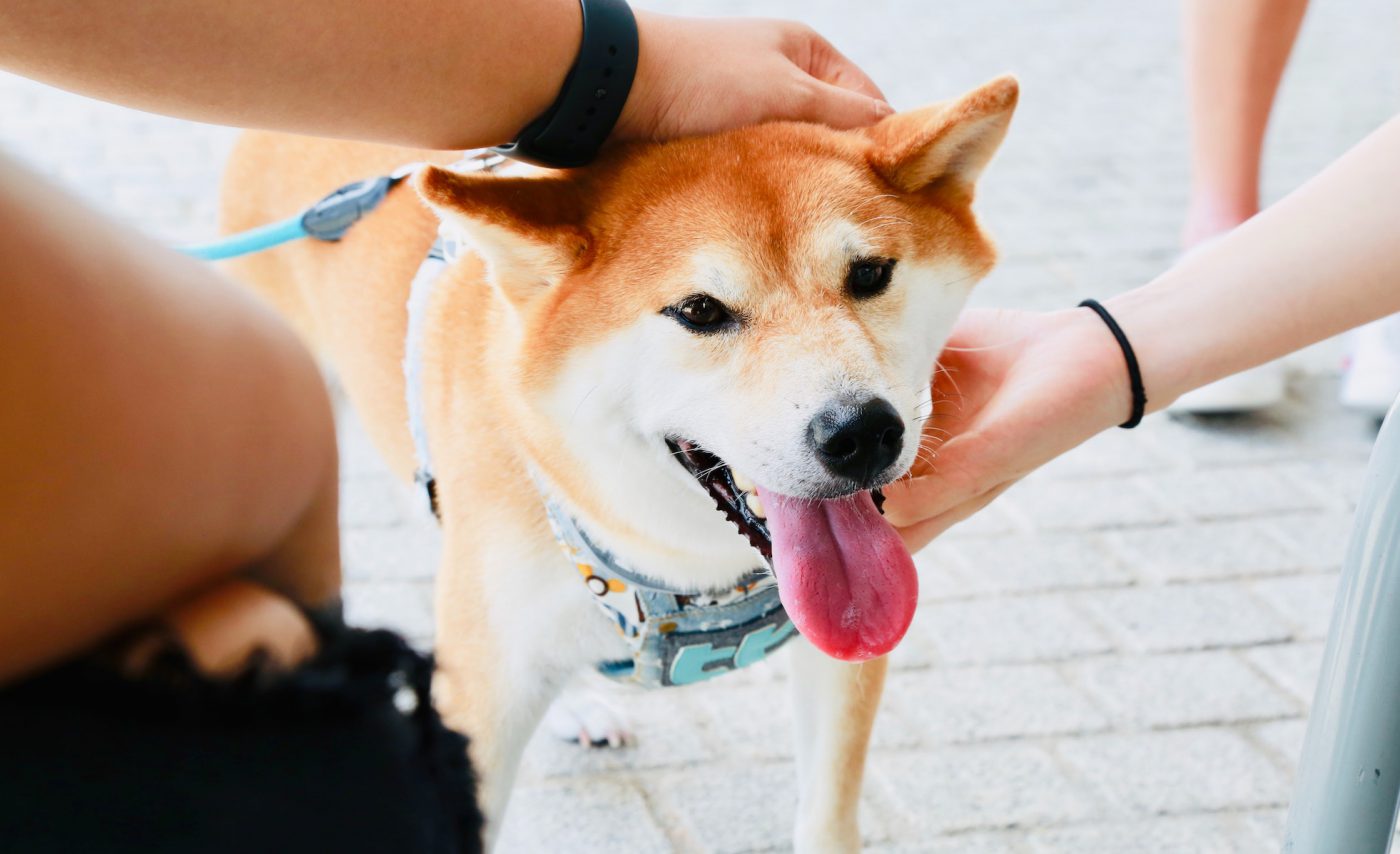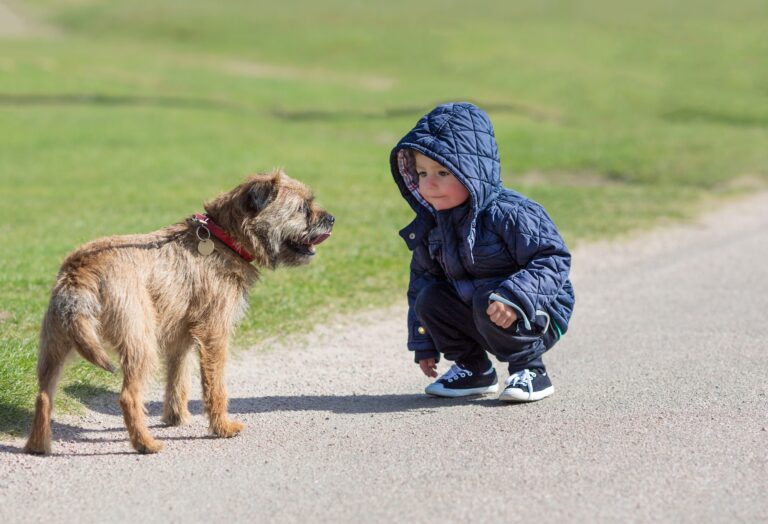There’s no arguing about dogs’ natural magnetism. For dog lovers, it’s the most natural thing in the world to want to pet, touch, interact with, and just be near every dog we see in the world. Unfortunately, many of the common things people do when they see dogs seem totally friendly to us but can be stressful or upsetting to dogs.
We ask our dogs to mind their manners in so many challenging ways each day; it’s the responsibility of dog lovers to also mind their own manners so that dogs (and dog owners) will be as happy to meet you as you are to meet them.
Here’s a video demonstration of the important stuff!
Below: more info on what to keep in mind about common canine interactions, and advice for how you can be a good friend to even dogs you don’t know.
Approaching a dog
Do ask first
As much as you probably love all dogs, not all dogs are friendly and eager to say hello to new people. It’s important to always ask permission before approaching someone’s dog, or petting their dog. Ask before touching, and always respect the wishes of the person holding the leash. There are lots of reasons why someone might not want their dog to say hello to you. The dog might be stressed by being approached by people they don’t know, or the dog’s person might be in a hurry, or actively training/working with their dog and not want to be distracted. And, simply, some dogs like to be pet by strangers more than others.
If you’ve been given permission to greet the dog, whenever possible let dogs approach you instead of approaching the dog. This gives the dog agency to determine if they will engage with you and if they’ll be comfortable in the interaction. If the dog approaches you eagerly, with a wagging tail, that’s a green light. If they look away, or move away from you, give them their space.
“I always say, when you meet a dog, keep your hands to yourself. Let the dog choose whether it wants to interact with you or not.” —trainer and founder of Consider the Dog, Tyler Muto
Do go easy on the eye contact
As beautiful as dogs are to behold, avoid making extended eye contact while approaching or petting a dog. While eye contact is the hallmark of a trustworthy person amongst us humans, to dogs it can be threatening coming from a stranger. Instead, if you’ve been given the OK to interact with a new dog, approach with your eyes slightly averted (or at least not maintaining steady eye contact) and your body angled a bit away. Speak gently and walk slowly.
Don’t loom
Similarly if you approach a dog, avoid leaning or hovering over them as that is likely to be perceived as threatening. As famed behaviorist, trainer, and author Patricia McConnell advocates in her book, The Other End of The Leash, try a side-on approach with your body slightly angled instead of a full-frontal approach. Allow the dog to move toward you. If you’re dealing with a dog who appears interested in interacting, you can invite them to approach you by bending slightly at the knees, and patting your thighs in encouragement.
Petting: You might be doing it wrong
The desire to pet dogs comes naturally to dog lovers. It’s also good for us, and good for dogs—multiple studies have shown that petting dogs can lower our cortisol levels, blood pressure, and anxiety, and lift our “feel-good” hormones like oxytocin. Dogs can reap benefits too—studies have shown that dogs respond more strongly to touch and voice versus just voice when greeted by a familiar person.
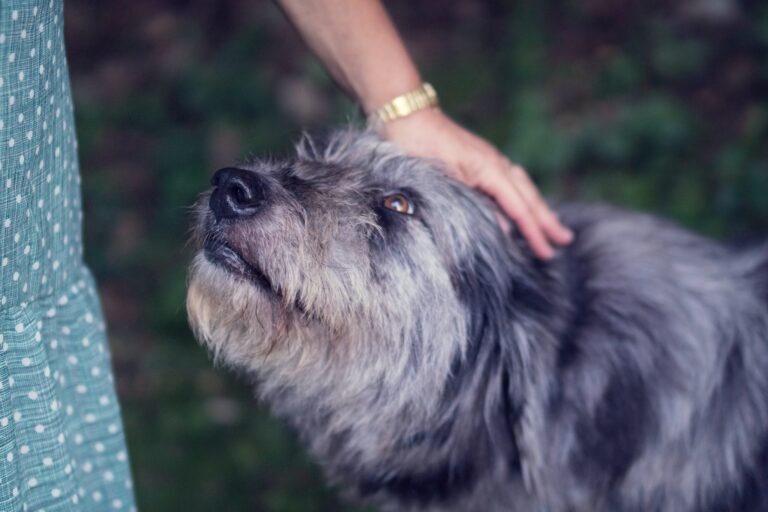
I’m tolerating this, but it’s not awesome.
It seems impossible that there’s any incorrect way to pet. But it’s possible you’ve been petting dogs wrong your entire life.
Unfortunately the way that most people pet dogs actually makes dogs uncomfortable.
Many people think nothing of walking right up to a dog they don’t know (which already can make a dog anxious), reaching over their head and starting to pat right on top of the head. Even though it’s one of the first places people reach for, most dogs generally don’t enjoy being pet on the top of their head, especially by strangers. The head pat, and having someone reach over or loom over them, can be interpreted as threatening gestures. If you observe your dog, or other dogs being approached in this way, there’s a good chance you’ll see them duck their head a bit, or flinch—those aren’t the signs of someone enjoying what’s happening.
Dogs are individuals and like to be pet in different ways. But, there are some good general rules for petting a dog you don’t know. If you’ve been given permission to pet a dog go for the following approach: rather than reaching out or reaching over the dog, allow them to initiate the contact and then, if they are game for being petted, instead of the top of the head, try petting under the chin or on the chest, neck, shoulder, side, or rump (no tail touching, please). Long gentle strokes along a dog’s back are more likely to be enjoyed than fast-paced back and forth petting.
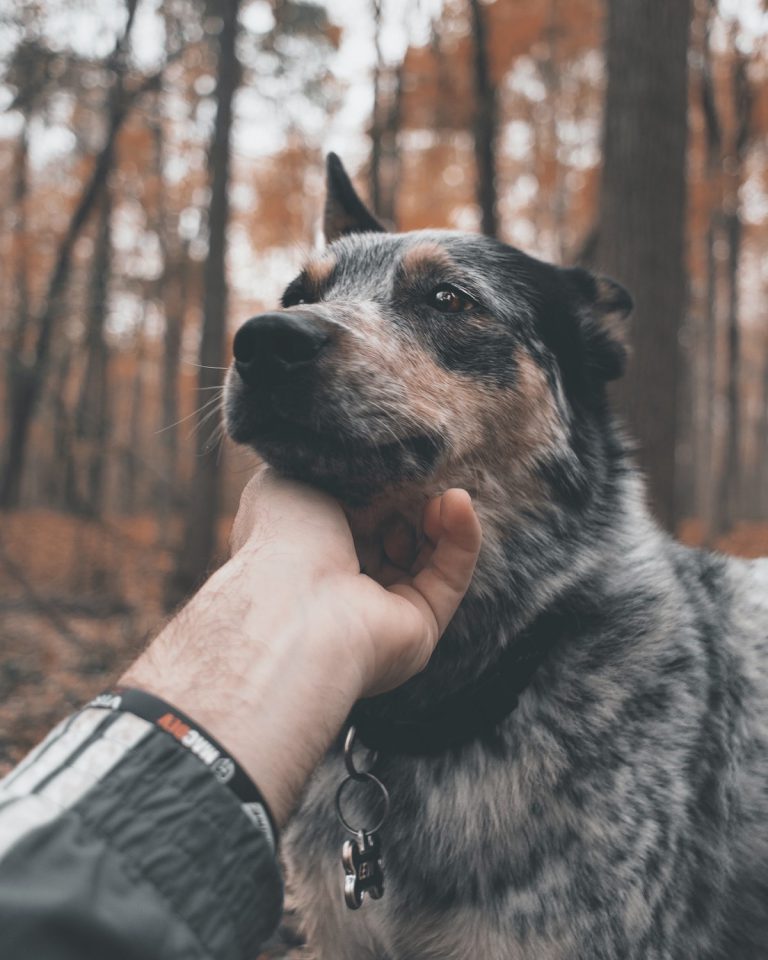
Yesss.
Don’t bother with the hand-sniff
Reaching out your hand for a dog to sniff isn’t necessary, and may be unwelcome. “It’s a myth that when you meet a dog, you should stick your hand in their face,” says Muto.
As humans when we meet someone we reach our hands out as a friendly gesture. “That’s not what dogs do; they don’t stick their paw out,” says Muto. “They don’t turn around and shove their butt in the other dog’s face.”
As we’ve noted in this space before, dogs’ noses are wondrous. They have about 300 million scent receptors to our five million. “Dogs don’t need your hand in front of their face; their sense of smell is incredible,” says Muto. “They can smell you from across a room. If they want to smell you they can smell your legs.” But more to the point he says, putting your hand in a dog’s face can be perceived as a threatening gesture. “Because we don’t learn as humans how to read body language, we don’t’ recognize the signs—and it could be as subtle as a shift of their eyes—that what we’re doing is actually making them uncomfortable. We think we’re doing a friendly thing but (hands) can be weapons to a dog. And that’s the way some dogs can interpret it—’look what I have so you better not mess around!’”
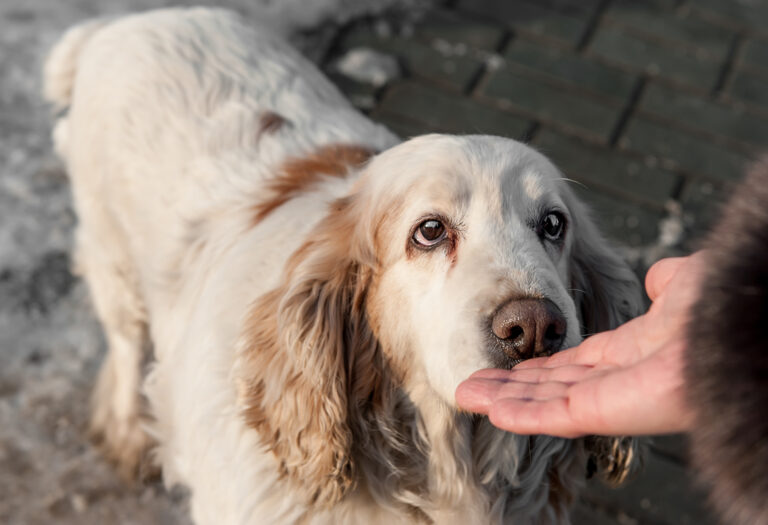
Why are you doing that?
But wait, you might be thinking. I’ve been reaching out my hand to dogs, and petting dogs, on the head this whole time and they seem ok with it. And some dogs may very well be. As noted, all dogs are different. And, well, dogs are amazing creatures and they tolerate a LOT from people. They may patiently sit through a head-patting, but that doesn’t mean they like it (if you look closely, you’ll notice that many dogs flinch or duck a bit when you reach over them to pet their heads). This leads us to…
Do study and look for body language
While it’s not always immediately obvious to us, dogs speak volumes with each other and with people through their body language. By learning more about canine body language you can increase your ability to interact well with dogs.
Unfortunately, people often don’t know or completely misunderstand some big cues on how a dog is feeling. Look out for stiffness of the body—if a dog freezes or stiffens up, that’s not a sign that they’re content. It’s a sign they want whatever is happening to stop.
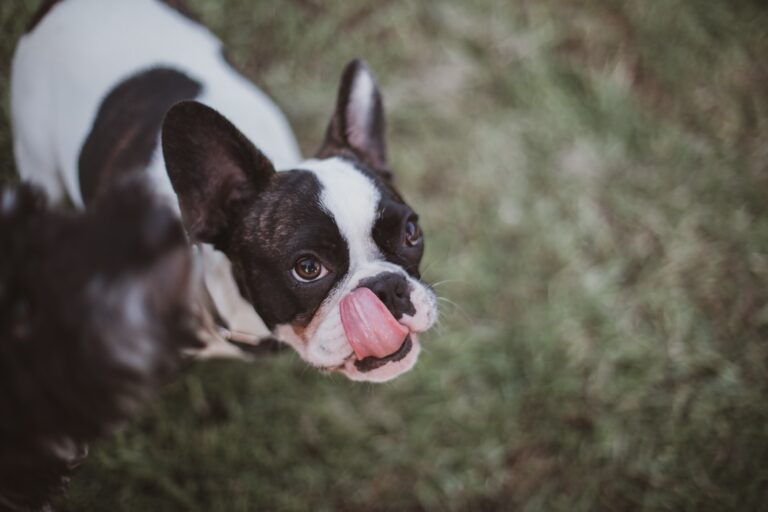
You might also see other small movements known as “appeasement gestures” like lip-licking or yawning. These are also signs of a dog who is nervously trying to cope, not a dog who’s calmly enjoying something. Is the dog’s mouth closed, with the lips drawn forward? This is another sign a dog may be annoyed, or anxious.
And, of course, consider the tail. Most people assume that a dog with a wagging tail is happy but that’s not always the case. A wagging tail only means that a dog is aroused. This could be because a dog is excited about what is happening, but it could also be because a dog is frustrated. Generally, the faster the dog’s tail is wagging the more aroused the dog is. Slow, wide tail wags that wiggle a dog’s entire body generally indicate a relaxed and happy dog. However, a fast sharp wag means that the dog is very alert or aroused and they might not be very happy about what is happening.
Tail position also matters. Dogs with tails tucked between their legs are generally fearful or stressed about what is happening, and the higher the tail the more confident the dog is. This will of course depend on the natural positioning of a dog’s tail, so a pug’s tail for example will have less position change than a golden retriever. Read more about decoding tails and wags here.
A word about hugging…
You can probably guess where we’re going here: don’t do it to a dog you don’t know (and there’s a good chance that your own dog doesn’t like it either). McConnell has also addressed this topic, noting that hugging is a trademark primate gesture of affection, but it’s simply not a thing in the canine world and it can be interpreted as dominance or assertiveness.
“Your own dog may benevolently put up with it but I’ve seen hundreds of dogs who growled or bit when someone hugged them,” McConnell writes. Again, look for signs. If your dog’s tongue is lolling out, they seem relaxed and are leaning into your hug, great. If their mouth is closed, they have their head turned away, or if they’re stiff, a dog may be politely putting up with something. And that’s not what anyone wants.
Kids and dogs
Kids love dogs and the feeling is often mutual. But if you’re out and about with your child, if they’re old enough, be sure they know the rules of engagement when it comes to approaching dogs they don’t know (if they’re not old enough, be sure they’re kept out of reach of dogs). Avoid letting your human child run up to a dog or pet a dog without clearing it with the owner. If they do engage, make sure they’re not jumping on the dog or petting too roughly.
Picking up a dog
A particular challenge for people who share their lives with small dogs is strangers wanting to pick the dog up. Most dogs, even small dogs, prefer to keep four on the floor, especially when it comes to engaging with strangers. Never pick up a dog you have just met. Not only can lifting up a dog you don’t know unintentionally scare the dog, or cause emotional discomfort, it can also lead to physical injury if the dog were to squirm out of your arms and fall. Injury can also easily occur if the dog has any preexisting condition you aren’t aware of that could be exacerbated by being lifted incorrectly.
If it’s ok to lift the dog, be sure to use proper technique—don’t hoist them using the front legs, and don’t lift from their belly. Watch our video on the right way to pick up dogs of different sizes.
Offering food to a dog
Many well-meaning people want to offer treats to dogs they meet, but this is definitely something to avoid unless you have permission.
Although a dog treat might seem harmless to you, you never know how a dog might respond to a particular food. Many dogs may be on specific diets, or have medical conditions or food intolerances, so giving a treat without permission is not only rude but it could actually make a dog sick! If you do want to give treats to a dog, always ask their guardian first and respect any “rules” they might set for allowing a treat, like asking the dog to sit first.
When engaging with dogs the key is to be intentional and thoughtful. As Muto would say, consider the dog. Remember that dogs have individual personalities, needs and desires. Always ask before approaching a dog and remember the person on the other end of the leash will be able to give you important information about what their dog likes and doesn’t like. As enjoyable as it is to pet dogs, it’s even more meaningful to learn about how dogs communicate and build mutually enjoyable friendships with dogs.



